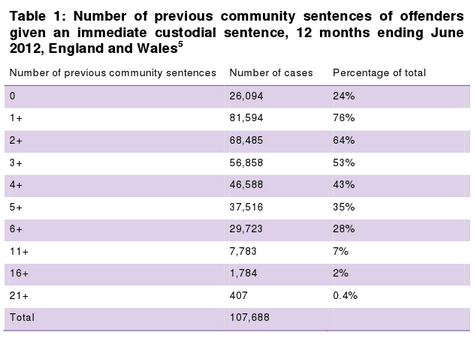Are criminals caught in a revolving door of community sentencing?
"8,000 criminals given community service ELEVEN times before being jailed: Britain's 'revolving door system' of non-custodial punishment revealed"
Daily Mail, 21 February 2013
As if headlines about high rates of prisoner reoffending weren't already familiar, parts of this morning's press turned their attention to community sentencing.
Citing research from the newly-formed Centre for Crime Prevention (CPP), the Daily Mail reported that 8,000 criminals sent to prison last year carried with them eleven or more previous bouts of comunity service, and that three quarters of criminals jailed had already given service.
The implication: community service doesn't work. The CPP was also in no uncertainty at the start of its report: "Community sentences are a failure."
So what's the evidence? The figures cited in the Mail came from a Freedom of Information (FOI) request by the CPP, in which it asked the Ministry of Justice for data regarding the community sentence histories of offenders convicted in the twelve months leading to June 2012.
Helpfully (and contrary to practice we've often witnessed from newspapers' FOIs) the CPP publish the data from their request, so we can see for ourselves what they found. Sure enough, a large proportion of offenders who were given an immediate custodial sentence had quite a number of previous community sentences behind them:

[Immediate custodial sentences include detention and training orders, young offender institutions, unsuspended imprisonment and sentences for public protection]
On their own of course, these figures only tell us that community sentences are far from perfect at preventing reoffending. To judge whether they are a failure is a more complex matter. One recurring comparison employed in the report is to place the reoffending rate of those on community orders with those sent to prison:

Full Fact analysed reoffending figures for various types of sentence last year. Public data from the Ministry of Justice (MoJ) does indeed back up what the graph says.
However, we need to be careful at judging the effectiveness of community schemes versus prisons from these figures. People sent to prison for several years differ in terms of the offences they will have committed and their own characteristics from those placed on community orders. The MoJ themselves attach a health warning to these figures, stating that:
"these figures should not be used when comparing proven reoffending rates across different disposals to compare effectiveness. Instead the 'Compendium of Re-offending Statistics and Analysis 2011' should be referred to as this analysis controls for offender characteristics in order to give a more reliable estimate of the relative effectiveness of different disposals." [emphasis added]
Controlling for the offenders' characteristics (finding matching groups of offenders in terms of age, gender, criminal history etc) found, among other things, a slightly higher reoffending rate for offenders sentence to under 6 months in prison compared to those receiving high-level community sentences. In addition:
"Offenders receiving Community Orders (COs) had lower re-offending rates than those given immediate custodial sentences of less than 12 months for all four years. In 2008 the difference was 8.3 percentage points."
Community sentencing fared better than short prison sentences - but the evidence in this area is patchy. Figures for longer sentences are problematic to get hold of - not least because they cease to compare like with like. The MoJ's figures analyse convictions for similar offences but different sentences, and this similarity is impossible to establish if comparing community orders with sentences of several years.
---
Flickr image courtesy of Sandwell Council